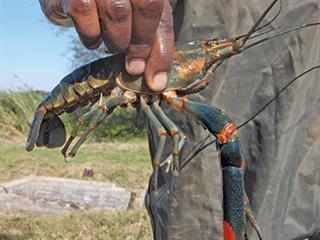
See the attached link to download a copy. Nord Eco is a unique Israeli freshwater crayfish eco-farm.

However in these conditions where freshwater crayfish are a secondary focus to cropping or livestock yields and returns will most likely be lower than semi-intensive systems where freshwater crayfish receive regular feeding and monitoring.
Freshwater crayfish farming. Freshwater crayfish farming is well established worldwide particularly in Europe and the United States with the industry still under development in Australia Hollows 2016. It is a spiny non burrowing freshwater crayfish found naturally in Western Australia. It is the highest valued freshwater crayfish farmed in Australia.
Another Australian crayfish that has also received some attention from growers world wide is the yabbie Cherax destructor. Care has been taken not to import the yabbie into other countries like South Africa because it is an. Nitrates are produced when bacteria oxidize nitrite.
Nitrate is less toxic to crayfish than nitrite but in high enough levels it can cause disease and stress the fish. Nitrates are best removed using live plants which use the chemical as a fertilizer. You can use freshwater plants in the pond itself or send the water through a hydroponic system.
Efforts to develop successful commercial tank systems for the cultivation of freshwater crayfish have a considerable history. Both in Australia and overseas years of work have been applied to this approach and yet the only commercially viable operations for redclaw are earthen pond based. KEEWAI have produced a guide to getting started for those interested in Freshwater Crayfish farming.
It covers aspects such as freshwater crayfish biology water quality and regulatory requirements and is a useful starting point for those new to the industry. See the attached link to download a copy. Freshwater Crayfish Farming A guide to.
The farming of freshwater crayfish astaciculture is mainly carried out in the southern states of the US and in Australia and Europe. At least equivalent amounts are harvested from the wild. Contrary to their larger cousins they do fine in small aquariums.
Something around 10 gallons 38L would be a great place to start. As with all aquarium inhabitants a filter is a must when keeping dwarf orange crayfish. Without it the tank wont cycle and your crayfish will be at risk.
Levels of freshwater crayfish production are predicted to show modest increases in 19992000 but are predicted to increase around threefold by 20042005 to a level of 1589 tonnes with a value of 20718 million. For the three species of commercially farmed freshwater crayfish yabby redclaw and marron the. Freshwater crayfish Eco Farm and Hatchery - Nord Eco.
Nord Eco is a unique Israeli freshwater crayfish eco-farm. It is the only crayfish hatchery in the Middle East region. At Nord Eco we produce and supply live crayfish for local clients such as restaurants and retail companies.
Also we sell craylings to farmers worldwide. A Guide to Getting Started draws on his experience as aquaculture manager for the Keewai project. This is a business initiated by forestry company Ernslaw One to gain additional revenue from the hundreds of fire ponds in its forests.
Normally they are only used in the event of a fire. Starting a crayfish farm is a challenging but innovative and rewarding business venture. A lot of the expense comes in building ponds and initially stocking.
A disadvantage of freshwater crayfish is their relatively low fertility rate. They produce as few as 300 eggs per spawn whereas ideal rates are 500 eggs or higher. Redclaw can however spawn up to three times a year if the conditions are right.
Freshwater crayfish aquaculture is in an early development stage with no farm currently producing large volumes of saleable stock freshwater crayfish farms but only four all in the South Island were in production. All are selling on the domestic market. 150 Fisheries Research Contract Report Western Australia No.
17 2007 Appendix 3 Successful Freshwater Crayfish Farming The Marron Model A manual for farmers of methods for managing marron ponds to improve husbandry and. Crayfish 3 Items Show 5 10 15 20 25 30 All per page. Farmers diversifying into freshwater crayfish in farm dams or harvesting from creeks under licence carry lower risk.
However in these conditions where freshwater crayfish are a secondary focus to cropping or livestock yields and returns will most likely be lower than semi-intensive systems where freshwater crayfish receive regular feeding and monitoring. The farming of freshwater crayfish astaciculture is mainly carried out in the southern states of the USA and in Australia and Europe. Production levels vary with climate but are in the region of 40 000 to 60 000 tonnes per annum.
Key 1 Crayfish Habitat Crayfish habitat is different from hides and it is essential for growing freshwater crayfish in tanks and ponds. Creating the most complicated habitat you can is very important for juvenile crayfish survival. Crayfish farming is usually either of an extensive ranching or semi-intensive nature intensive methods being infrequent except for the rearing of juveniles for stocking or restocking of natural waters depleted of crayfish.
Dynamics of omnivorous crayfish in freshwater ecosystems. A review of astaciculture. Freshwater crayfish farming - Volume 6 Issue 4.
We use cookies to distinguish you from other users and to provide you with a better experience on our websites. Marron are the largest farmed freshwater crayfish in the world. Only two species native to Tasmania grow to a larger size however these are not produced commercially.
Marron are grown in ponds and dams designed to optimise their growth and to allow for ease of management and harvesting. Marron breed only once per year during early spring when.